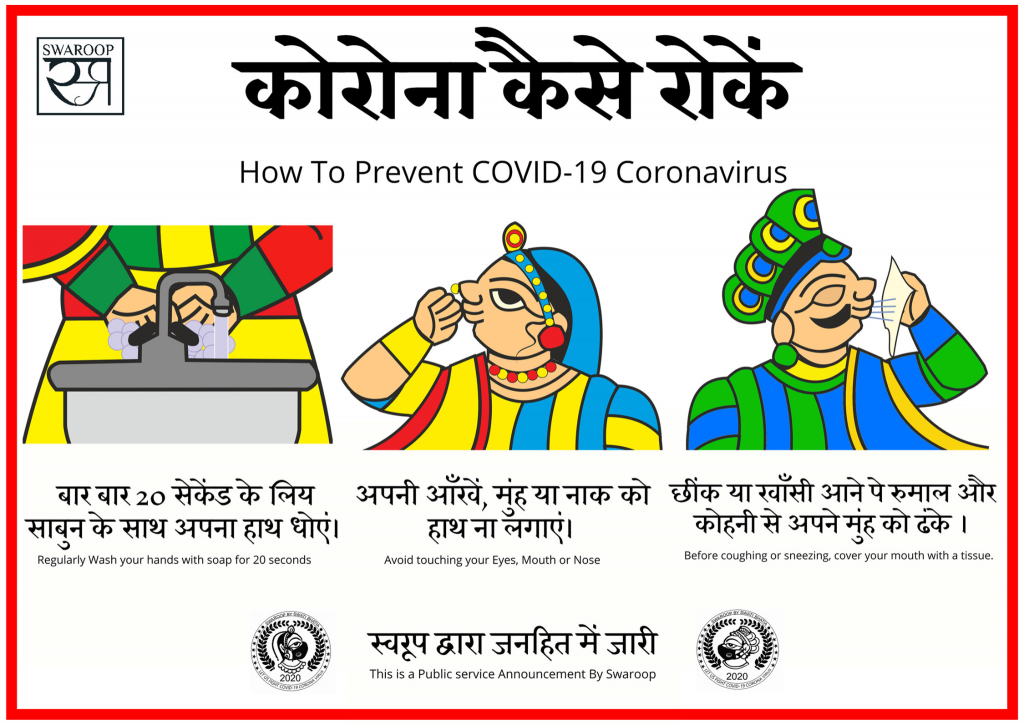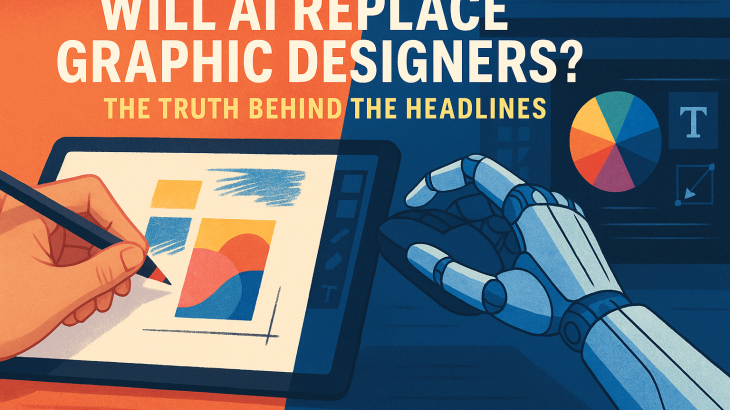The world of design is going through a major shift. New AI-powered tools are changing the way we create visuals. Tasks that used to take designers hours or even days can now be done in minutes with the help of these tools. It’s fast, convenient, and honestly, quite exciting.
But with all this rapid change, there’s also a growing sense of uncertainty, especially among students and young designers. One question keeps coming up in classrooms, interviews, and online discussions: “Will AI replace me as a designer?”
The concern is valid. If a machine can do what you’re learning to do, what’s your role in the future? In this blog, we’ll explore what AI can and can’t do, how human creativity still leads the way, and how design students can prepare for the future with the right mindset and skills.
What AI Can Do in Design
AI is fast, consistent, and incredibly efficient at certain design tasks. Whether you’re a professional or just someone with an idea, today’s AI tools make it easy to get started.
How AI Makes Design Work Smarter, Not Harder?
Tools like Canva’s Magic Design or Adobe Firefly let users type in a short description—like “a modern travel poster with beach elements”—and instantly receive layout suggestions with images, text placement, and design styling done.
- Multi-Platform Ready in Seconds
Creating a post for Instagram and then adapting it for LinkedIn, Twitter, or Stories used to take time. Now, platforms like Canva’s Smart Resize or Adobe Express can automatically adjust your design to fit various dimensions, with just one click.
- Backgrounds Gone in a Blink
What used to take 15–20 minutes of manual selection in Photoshop is now done in 3 seconds with AI-powered background remover tools.

- Style Suggestions at Your Command
Many AI design platforms offer smart recommendations that pair the right typography and colors based on your theme or brand keywords. For example, if you input “eco-friendly brand,” the tool may suggest earthy greens, organic textures, and clean, minimal fonts.
- From One Template to a Hundred Posts
Bulk-generating hundreds of social media graphics with slight variations (text change, date, product name) is now easy using AI-driven batch processing or smart templates.
AI excels at repetition, automation, and quick ideation. It’s ideal for high-volume design tasks, template-based visual production, and speedy mockups, saving time for both beginners and professionals. AI is likely to become even more capable in the future, but creating a design that is strategic, culturally relevant, and emotionally resonant still requires a human touch, and that’s where designers continue to lead.
What Graphic Designers Can Do That AI Can’t
A graphic designer isn’t just someone who arranges fonts and colors on a page; they are visual thinkers who solve problems, understand emotions, interpret culture, and create meaning.
Here’s what sets human designers apart—with real-world context:
- Creative Intent
AI follows existing patterns. It pulls from data and trends to generate results that are often safe or formulaic. But human designers can break patterns. They can invent completely new visual styles or challenge expectations based on the design’s purpose.

For instance, take the rebranding of Airbnb. Instead of going with a typical icon or a literal house symbol, the human-led design team created the symbol, a blend of heart, location pin, and “A” that reflects belonging. AI might have created something more obvious or generic, but it took human insight to capture the brand’s deeper emotional message.
Designers have the ability to sense and reflect subtle emotions in their work. Whether it’s nostalgia, urgency, or calmness, they choose visuals that feel right for the audience.
A mental health awareness campaign poster might use soothing colors, handwritten typography, and breathing space. An AI might just generate a generic health-related graphic, missing the emotional tone completely.

Designers are tuned in to context. They understand how symbols, colors, and visuals are interpreted differently across regions or cultures. In India, red often symbolizes celebration or weddings, while in Western countries, it may signal danger. A designer knows when to use red for joy and when to avoid it. AI, without context, might misuse these cues.
Great design is never just decoration—it’s narrative. Designers can build a brand story through fonts, illustrations, layouts, and pacing. A travel brochure designed by a human can tell a visual story: starting with discovery, followed by adventure, and ending in relaxation. AI can throw in travel images and nice layouts, but it won’t weave a journey through design.

Designers are aware of how their visuals impact people. They avoid stereotypes, promote inclusion, and are mindful of audience sensitivities.
For example, consider a public health campaign aimed at rural communities. A human designer would carefully choose culturally appropriate imagery, language, and colors to ensure the message feels respectful and relatable. AI, unaware of local nuances, might use generic or urban-centric visuals that feel disconnected or even offensive to the target audience.

A design created by AI might look nice, but that’s where it ends. A design by a human can carry values, reflect heritage, and evoke emotion. That difference is everything. Because in the end, design is about meaning, and meaning comes from human experience, something no machine can replicate.
Designers + AI – The Collaborative Future
Instead of resisting AI, forward-thinking designers are learning to work with it, not against it. The smartest creatives today understand that AI isn’t here to take their job, it’s here to transform how they work. AI is not a competitor. It’s a creative co-pilot that handles repetitive, technical, or time-consuming tasks so designers can focus on the bigger picture: strategy, storytelling, and innovation.
You can quickly generate mood boards and visual references to support client presentations or creative brainstorming sessions. When exploring different concepts, AI helps you test multiple styles or variations before deciding on a final direction. When it comes to production work like resizing graphics, adapting content for different platforms, or removing backgrounds, AI speeds things up, allowing you to focus more on creativity and big-picture thinking.
What Design Students Should Focus On
If you’re a student joining a graphics designing course , this is an exciting moment. But it also requires clarity. Instead of fearing AI or overusing it for every task, focus on what it can’t do—and double down on the strengths that only you can bring.
Here’s what matters most now:
- Adaptability: The tools will keep changing. What stays relevant is your ability to think, learn, and lead.
- Creative Problem-Solving: AI can give you outputs. Only you can ask the right questions.
- Design Thinking: Learn how to research, empathize, and create solutions—not just visuals.
- Your Visual Voice: Develop a style, a point of view, a signature. AI can’t replicate individuality.
- Storytelling & Communication: Be the person who connects the dots and explains why design choices matter.
If you would like to explore more on this, read here
At ARCH, students are prepared not just for today’s creative industry, but for its future. Through a dynamic curriculum across courses in graphic design, communication design, fashion design, interior design, and jewellery design, ARCH equips students with the right balance of creative thinking and technological fluency. By integrating AI tools into classroom learning and encouraging hands-on experimentation, the college ensures students understand how to use AI effectively, without losing their voice. Whether it’s for concept development, visual storytelling, or collaborative projects, ARCH helps future designers adapt, innovate, and lead in a tech-enabled design world.
